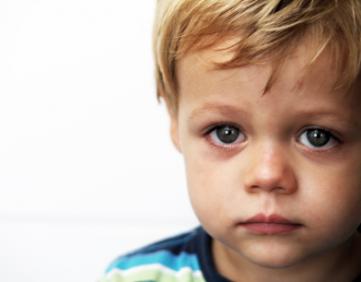By Kellie Anderson

When you hear the term “toxic stress” in relation to young children, you probably think of kids living in areas of famine, war, or civil unrest in distant countries. But as I learned at a recent conference, the sad reality is that many children right here in the United States live in environments of toxic stress.
In April, I attended the Project LAUNCH grantee meeting in Arlington, Virginia, and the opening plenary by David Willis, MD, FAAP, director of the Division of Home Visiting and Early Childhood Systems in the Department of Health and Human Services, really resonated with me. In his presentation, Dr. Willis explained how toxic stress can adversely affect brain development in young children, causing long-term, negative consequences for learning, behavior, and health.
According to the Center on the Developing Child at Harvard University, toxic stress occurs “when a child experiences strong, frequent, and/or prolonged adversity—such as physical or emotional abuse, chronic neglect, caregiver substance abuse or mental illness, exposure to violence, and/or the accumulated burdens of family economic hardship—without adequate adult support.”
I’ve added the emphasis to the end of the definition because this is a salient phrase: There is a point of influence at which you and I can help kids recover from the toxic stress they are exposed to every day in homes and neighborhoods in which poverty, violence, and substance abuse are the norm.
The Effects of Toxic Stress
The effects of toxic stress cannot be overstated, Dr. Willis explained, and he exemplified this by describing the disparities in early vocabulary growth among children from families of different socio-economic statuses.
Dr. Willis’s data showed differences in speech development among children from “welfare,” “working class,” and “professional” families. While all have equal speech development at 12 months of age, inequalities begin to appear around 18 months and are significant at 36 months, with kids from professional families saying an average of 1,116 words, working families’ kids saying 749, and kids from welfare families—those who, generally, experience the most toxic stress—speaking just 525 words. If you project these effects onto other developmental milestones throughout childhood, it’s clear just how much toxic stress affects children.
Dr. Willis also presented findings from the Adverse Childhood Experiences (ACE) study, which analyzes data on adverse childhood experiences (toxic stressors) and the resulting negative consequences. He showed that the greater the number of adverse childhood experiences—including abuse, neglect, and parental substance abuse—the more profound the impact on school success and health. Kids with three or more adverse experiences are at much greater risk of academic failure, attendance problems, behavioral issues, and poor health than those with fewer toxic stressors. (See The Truth About ACEs, an infographic by the Robert Wood Johnson Foundation.)
Combating Toxic Stress
It may therefore seem a foregone conclusion that kids growing up in toxic stress, mostly those in poorer social-economic environments, will fare worse than their middle-class peers because the factors that cause toxic stress are so ingrained in our society and so difficult to influence. However, Dr. Willis introduced the concept of “ladders of opportunity” for children from at-risk communities—the idea that by providing supportive relationships, stimulating experiences, and health-promoting environments, we can mitigate the effect of toxic stress on children’s developmental trajectories. Put simply, if we band together to form a network of support for at-risk children and their families, we can positively influence their development and alleviate the effects of toxic stress.
Without caring adults to buffer children, the unrelenting stress caused by extreme poverty, neglect, abuse, or severe maternal depression can weaken the architecture of the developing brain, with long-term consequences for learning, behavior, and both physical and mental health . . . Research shows that, even under stressful conditions, supportive, responsive relationships with caring adults as early in life as possible can prevent or reverse the damaging effects of toxic stress response.
—Center on the Developing Child, Harvard University
Much of the work that National Center grantees already do—implementing evidence-based practices and programming to influence youth’s development and learning—is crucial to children’s academic, social, and emotional success. According to Dr. Willis, we can further these efforts by doing the following:
- Promoting relational health between children and their caregivers in the crucial first 36 months of life, when the complex neurodevelopment that will influence a child’s social-emotional development occurs. Something as simple as looking infants in the eyes instead of placing them in front of the TV positively stimulates their brain development. We can likewise encourage caregivers of toddlers to read and talk to children instead of giving them toys to play with in solitude. The best part about caregivers supporting their children’s relational health is that it is simple and free!
- Supporting kindergarten readiness by having high-quality, affordable preschool programs available to all children. We can also teach parents and guardians about the benefits of preschool and about appropriate discipline.
- Advocating for preventive mental health for children prior to and during the school years. Such programming may include home visiting for infants and integrating behavioral health screening into primary care for all children.
- Strengthening systems that address the social determinants of health, including providing family strengthening and parent skills training and parent support services, expanding early childhood services at the local and state levels, and developing innovative financing structures for early childhood systems.
These steps help diminish the effects of toxic stress and create the right conditions for healthy development in early childhood, which is much more effective and much less costly than trying to address problems later on.
Your Turn
Do you have experience with making a difference in the lives of children living in environments of toxic stress? Which strategies seemed to work, and which didn’t? We’d like to hear your story.*
Don’t miss out—sign up to receive our blog, Promote Prevent Perspectives, in a weekly email!
*E-mail addresses will be kept confidential.